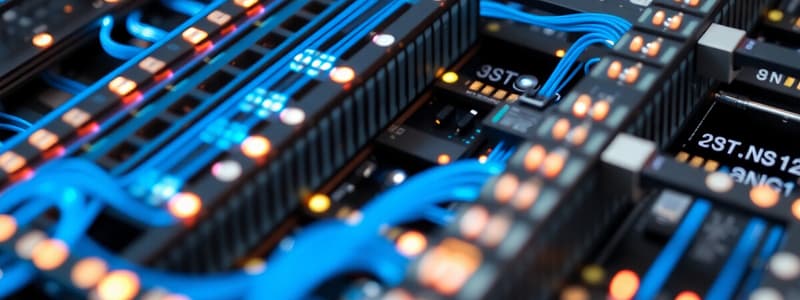Podcast
Questions and Answers
Which of the following best describes the fundamental difference between circuit switching and packet switching in telecommunications?
Which of the following best describes the fundamental difference between circuit switching and packet switching in telecommunications?
- Circuit switching prioritizes data packets based on their source, while packet switching treats all packets equally regardless of origin.
- Circuit switching dynamically allocates bandwidth based on traffic demand, while packet switching statically assigns bandwidth regardless of usage.
- Circuit switching uses a shared network path for all data packets, while packet switching establishes a dedicated physical path between source and destination for the duration of the communication.
- Circuit switching reserves a dedicated physical path for the duration of the communication, while packet switching uses multiple routes to send packets over data networks. (correct)
In the context of early mobile telecommunications in India, the introduction of Reliance's mobile phone service priced at ₹500 with a charge of 50 paisa per minute had no significant impact on reducing incoming call charges.
In the context of early mobile telecommunications in India, the introduction of Reliance's mobile phone service priced at ₹500 with a charge of 50 paisa per minute had no significant impact on reducing incoming call charges.
False (B)
Explain the role of the International Telecommunication Union (ITU) in standardizing telecommunication technologies, and provide an example illustrating its impact on device compatibility.
Explain the role of the International Telecommunication Union (ITU) in standardizing telecommunication technologies, and provide an example illustrating its impact on device compatibility.
The ITU governs telecommunication standardization, ensuring compatibility between devices and network elements. For instance, the standardization of USB interfaces by IEEE, under ITU oversight, guarantees that USB pen drives from different manufacturers can interface seamlessly.
In the context of 2G mobile networks, the acronym BTS stands for ______, which serves as the radio transceiver station directly communicating with mobile phones.
In the context of 2G mobile networks, the acronym BTS stands for ______, which serves as the radio transceiver station directly communicating with mobile phones.
Match the following mobile network identifiers with their respective functions:
Match the following mobile network identifiers with their respective functions:
Why did early 2G systems divide cell sites into sectors, and what was the immediate impact on frequency reuse?
Why did early 2G systems divide cell sites into sectors, and what was the immediate impact on frequency reuse?
While 3GPP proposed WCDMA for third generation GSM technology by borrowing CDMA concepts, 3GPP completely abandoned CDMA's underlying principles in their final architecture.
While 3GPP proposed WCDMA for third generation GSM technology by borrowing CDMA concepts, 3GPP completely abandoned CDMA's underlying principles in their final architecture.
Contrast the roles of the Base Transceiver Station (BTS) and the Base Station Controller (BSC) within the 2G network architecture. What critical function does the BSC perform in managing radio resources?
Contrast the roles of the Base Transceiver Station (BTS) and the Base Station Controller (BSC) within the 2G network architecture. What critical function does the BSC perform in managing radio resources?
The evolution from 2G to 2.5G involved the addition of ______ to voice services, marking the beginning of data services over wireless networks.
The evolution from 2G to 2.5G involved the addition of ______ to voice services, marking the beginning of data services over wireless networks.
Match the following mobile telecommunication technologies with their approximate maximum data speeds:
Match the following mobile telecommunication technologies with their approximate maximum data speeds:
In the context of cellular network frequency allocation, what is the primary reason for the government's involvement in spectrum auctions, and what implications does this have on the telecom industry?
In the context of cellular network frequency allocation, what is the primary reason for the government's involvement in spectrum auctions, and what implications does this have on the telecom industry?
WiMAX ultimately achieved global adoption and interoperability with GSM networks, making it a dominant 4G technology alongside LTE.
WiMAX ultimately achieved global adoption and interoperability with GSM networks, making it a dominant 4G technology alongside LTE.
Explain the concept of sectorization in 2G networks. How does it address the limitation of accommodating only a small number of users per cell site, and what are the trade-offs?
Explain the concept of sectorization in 2G networks. How does it address the limitation of accommodating only a small number of users per cell site, and what are the trade-offs?
Within the 2G GSM architecture, the ______ is responsible for controlling one or more BTSs; its primary function includes radio resource management and handover control.
Within the 2G GSM architecture, the ______ is responsible for controlling one or more BTSs; its primary function includes radio resource management and handover control.
Match the historical periods with key developments in the Indian telecommunications sector:
Match the historical periods with key developments in the Indian telecommunications sector:
What was the impetus behind the 3GPP suggesting a technology based on CDMA for 3G GSM?
What was the impetus behind the 3GPP suggesting a technology based on CDMA for 3G GSM?
In 2G systems, adjacent cell sites are permitted to operate on the same frequency to maximize network efficienty and coverage effectiveness.
In 2G systems, adjacent cell sites are permitted to operate on the same frequency to maximize network efficienty and coverage effectiveness.
Explain the significance of MSISDN and IMSI in mobile telecommunications. Differentiate their usage and purpose, from a network perspective.
Explain the significance of MSISDN and IMSI in mobile telecommunications. Differentiate their usage and purpose, from a network perspective.
The division of cells into sectors is known as ______, aimed at increasing network capacity and reducing interference.
The division of cells into sectors is known as ______, aimed at increasing network capacity and reducing interference.
Match the standards with the mobile network generations:
Match the standards with the mobile network generations:
Flashcards
What is 5G?
What is 5G?
The fifth generation of mobile telecommunications networks.
What is circuit switching?
What is circuit switching?
A type of network switching where physical resources are reserved for the duration of a call.
What is packet switching?
What is packet switching?
A type of network switching where data is divided into packets and sent over a shared network path.
What is GSM?
What is GSM?
Signup and view all the flashcards
What is CDMA?
What is CDMA?
Signup and view all the flashcards
What is 3GPP?
What is 3GPP?
Signup and view all the flashcards
What is ITU?
What is ITU?
Signup and view all the flashcards
What is IMSI?
What is IMSI?
Signup and view all the flashcards
What is MSISDN?
What is MSISDN?
Signup and view all the flashcards
What is IMEI?
What is IMEI?
Signup and view all the flashcards
What is BTS?
What is BTS?
Signup and view all the flashcards
What is BSC?
What is BSC?
Signup and view all the flashcards
Study Notes
5G Core Training Introduction
- The 5G core training assumes some familiarity with previous generations of mobile networks (2G, 3G, 4G).
- The course aims to bridge the gap for individuals without prior knowledge of wireless communication.
Circuit Switching
- Circuit switching reserves physical resources for a dedicated connection between two points.
- Analogy: A separate road is assigned for a trip from Delhi to Gurgaon, ensuring smooth travel.
- Historical context: In old movies, telephone exchanges manually switched calls.
- Landline connections and early 2G calls used circuit switching for high quality.
- Time division and frequency division were introduced to allow more users to utilize resources.
Packet Switching
- Packet switching is like a normal road where no resources are reserved.
- Call quality can be impacted due to shared resources (e.g., WhatsApp calls).
- Delay can occur as network elements use any possible route to send data packets.
- Packet switching allows efficient use of network resources and accommodates more users.
- Circuit switching establishes a physical path, while packet switching does not.
- In circuit switching, all messages use the same path, and bandwidth is reserved.
- In packet switching, paths can vary for each message, and bandwidth is not reserved.
Evolution of Mobile Networks in India
- In the 1990s, India had a single landline provider, and the government controlled telecommunications.
- GSM networks were introduced in 1995.
- BSNL was created, and new licenses were issued to companies like Bharti, Spice Mobile, and MTNL.
- Reliance introduced affordable mobile phones in 2002, reducing call costs and removing incoming call charges.
- The telecom 2G scam arose after more licenses were given to companies like Videocon, Aircel, and MTS in 2008.
- In 2010, the government auctioned licenses for 3G and 4G spectrum.
- 3G services started in 2011, and 4G services after 2015.
- India's spectrum auction had the highest license cost globally.
- The base price for 5G spectrum is high, impacting the auctioning process.
- The Indian market is now dominated by 2-3 players due to financial losses of companies like Airtel and Vodafone.
Wireless Communication Standards
- 3GPP (Third Generation Partnership Project) was established in the late 90s.
- 3GPP created a reference architecture for 3G networks to enhance data speeds.
- ITU (International Telecommunication Union), part of the United Nations, governs telecommunication standardization.
- IEEE standardizes interfaces, ensuring compatibility across devices and network elements.
- GSMA (Global System for Mobile Communication) is a global system for mobile communication.
- GSMA is an association of GSM telecom operators that organizes the Mobile World Congress in Barcelona.
Evolution of Wireless Generations
- Wireless technology started with 1G, using analog voice.
- 2G (GSM) introduced digital technology with parallel technologies like CDMA.
- CDMA (Code Division Multiple Access) was used by the American army for secure communication.
- The first generation of CDMA for voice was called IS95A.
- 2.5G added data to voice with GPRS, providing wireless data services at around 114 kbps.
- A parallel technology for CDMA was CDMA IS95B.
- 2.75G or EDGE improved data speeds to 384 kbps using modulation techniques.
- GSM and CDMA technologies evolved to 3G without a 2.75G version for CDMA.
- 3GPP proposed WCDMA (Wideband CDMA) for 3G GSM technology, using a wide band to achieve speeds of 2 Mbps.
- 3GPP later introduced HSPA (High Speed Packet Access) to increase 3G speeds from 2 to 8 Mbps.
- The third generation of CDMA was called CDMA 2000, leading to HSPA+.
- 3.5G included CDMA EVDO (Evolution-Data Optimized) for enhanced video data output.
- TATA Docomo dongles and MTS (Russian operator) used CDMA EVDO for data services.
- In 2008, 3GPP launched LTE (Long Term Evolution) or fourth generation networks.
- CDMA evolution stopped after 3.5G or EVDO.
- WiMAX (Worldwide Interoperability for Microwave Access) was promoted by Qualcomm.
- A debate occurred in 2010 whether Indian operators should adopt WiMAX or LTE.
- BSNL deployed WiMAX, but most operators chose LTE due to their existing GSM-based infrastructure.
- WiMAX operators faced development and interoperability issues with GSM.
- LTE evolved to LTE advanced with speeds around 300 Mbps, then LTE advanced pro with speeds around 1 Gbps.
- 5G is the fifth generation of internet cellular standards.
2G Identifiers
- MSISDN (Mobile Station International Subscriber Directory Number) is the technical term for mobile numbers.
- In India, it starts with a country code followed by a 10-digit number.
- China has 11-digit mobile numbers.
- IMSI (International Mobile Subscriber Identity) is a unique identifier for each customer.
- IMSI is used by network elements to identify a customer, unlike MSISDN, which is used by people to dial numbers.
- IMSI is 15 digits long, starting with a 3-digit mobile country code (e.g., 404 for India), followed by 2 digits of mobile network code and 10 digits of the subscriber's serial number.
- IMEI (International Mobile Equipment Identity) identifies mobile equipment such as handsets, Apple Watches, or tablets
- IMEI has 14-15 digits with the first 6 digits identifying the manufacturer, the next 2 digits identifying the model, and the last 6-7 digits as the serial number.
Wireless Cell Sites
- A cell site is the area covered by a tower in wireless telecommunication, represented in a hexagonal shape.
- In 2G systems, operators purchased frequencies from the government for use in cell sites.
- Each cell site was assigned a frequency, accommodating about 8 people at one time.
- Sectorization was implemented to increase capacity by dividing cells into sectors to service more clients
- Cell sites were divided into 3 sectors of 120 degrees, using 3 frequencies.
- Using 4 sectors allow usage of 4 frequencies on a tower.
- Adjacent cell sites in 2G could not have the same frequency to avoid interruption.
- The same frequency could be reused if cell sites were separated by another cell site.
- 2G communication was standardized by ITU on 900 MHz, later expanded to 1800 MHz.
- India uses 2.1 GHz (2100 MHz) for 3G and 2300 MHz for 4G LTE.
- Lower frequencies provide broader coverage such as 93.5 red FM.
- 900 MHz band frequencies are more expensive than 1800 MHz frequencies.
2G Architecture
- GSM technology was used for 2G, primarily for calls and low-speed internet.
- A mobile phone connects to a tower, which is a supporting element.
- The antenna sends signals and connects to the mobile phone.
- The antenna, tower, and generator form the BTS (Base Transceiver Station).
- BTS, BSC, and MSC are key terms in telecommunication.
- BTS is the antenna combined with the tower acts as a base station.
- The antenna both sends and receives signals, acting as a transceiver.
- BSC (Base Station Controller) controls multiple BTSs.
- BTS is a "dumb device" controlled by the BSC.
- Mobile phones are technically referred to as MS (Mobile Station) or UE (User Equipment).
- The BSC governs frequency and time slot allocation for calls, including setting up and aligning channels.
Studying That Suits You
Use AI to generate personalized quizzes and flashcards to suit your learning preferences.




